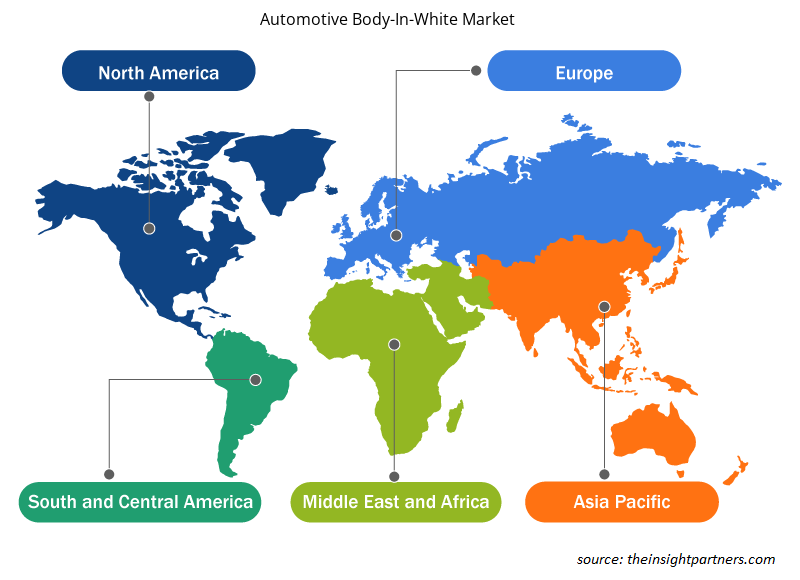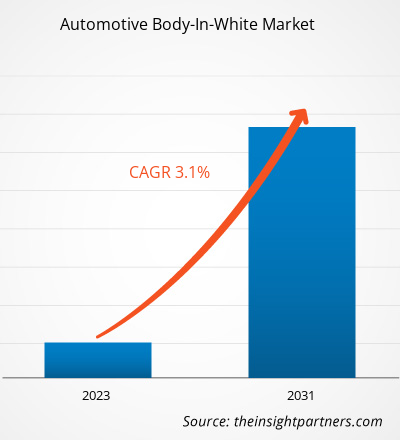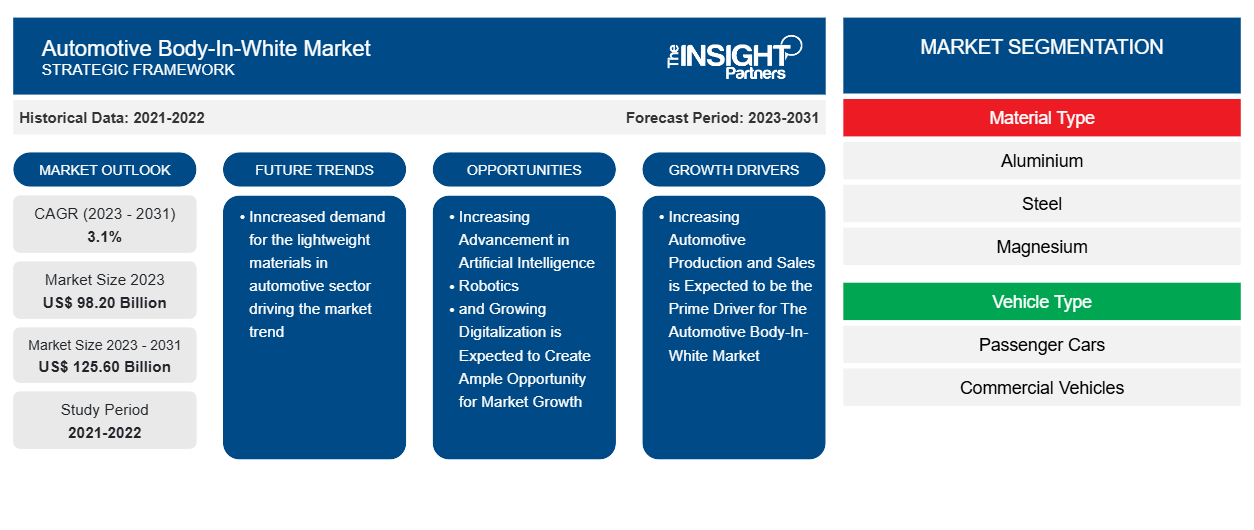Der Markt für Rohkarosserien soll von 98,20 Milliarden US-Dollar im Jahr 2023 auf 125,60 Milliarden US-Dollar im Jahr 2031 anwachsen. Der Markt soll in den Jahren 2023–2031 eine durchschnittliche jährliche Wachstumsrate von 3,1 % verzeichnen. Der weltweit steigende Absatz von Elektrofahrzeugen treibt das Wachstum des Marktes für Rohkarosserien voran. Rohkarosserien sind Metallkarosseriestrukturen, die in der Automobilproduktion verwendet werden. Rohkarosserien sind die Außenkomponenten wie Motorhaube, Türen und Kofferraumdeckel. Sie bestehen aus Hauptrahmen, Querträgern, selbsttragender Karosserie, Hilfsrahmen und anderen Stützstrukturen, die das Fundament des Fahrzeugs bilden.
Analyse des Automobilkarosserie-Marktes
Die Rohkarosserie besteht aus dem Rahmen und der Stahlstruktur für die Automobilproduktion auf der ganzen Welt. Die Karosseriestruktur besteht aus einer rahmenmontierten Struktur und einer Monocoque-Struktur. Die wachsende Automobilproduktion auf der ganzen Welt treibt das Wachstum des Marktes für Rohkarosserie voran. Laut der India Brand Equity Foundation Organization stiegen die Pkw-Verkäufe in Indien um 3,2 % und erreichten im Dezember 2023 242.920 Einheiten. Die Fahrzeugverkäufe von Oktober bis Dezember 2023 stiegen um 7,4 % und erreichten 1.247.614 Einheiten. Darüber hinaus stiegen die weltweiten Verkäufe von leichten Fahrzeugen im Jahr 2024 im Vergleich zum Vorjahr um 2,8 %.
Marktübersicht für Automobilkarosseriebau
Bei der Rohkarosserie von Autos wird der Rahmen des Fahrzeugs montiert, nicht lackiert. Es handelt sich um die geschweißte Karosserie ohne Fahrgestell-Baugruppen, Motor und Getriebeleitungen. Es handelt sich um die Außen- und Innenverkleidungskomponenten wie Türschlösser, Glas, Griffe, Sitze, Polsterung, Elektronik usw. Unternehmen wie Toyota Corporation, Nissan Corporation, Tata Motors, Kia Motors und viele andere verwenden die Rohkarosserie von Autos. Der wichtigste Antriebsfaktor für das Wachstum des Marktes für Rohkarosserie von Autos sind die steigenden Verkaufszahlen von Elektromobilität, die leichte Materialien erfordert, um die Lebensdauer der Batterie zu verbessern. Die zunehmende Entwicklung der Automobilindustrie auf der ganzen Welt und der zunehmende Ausbau der Automobilproduktionskapazitäten sind die wichtigsten Antriebsfaktoren für das Wachstum des Marktes für Rohkarosserie von Autos. Mehrere Hersteller entwickeln das für die Automobilproduktion verwendete Rohmaterial. Mehrere Materialien wie Aluminium, Kohlefaser, Magnesium und andere werden für das Wachstum des Marktes für Rohkarosserie von Autos verwendet. Diese Materialien sind langlebiger, reduzieren das Fahrzeuggewicht und verbessern die Effizienz.
Die weltweit steigende Automobilproduktion treibt das Marktwachstum voran.
Die Automobilindustrie ist mit der technologischen Entwicklung der Mobilität ein anspruchsvoller Sektor. Der weltweite Anstieg des Verkaufs von leichten Elektrofahrzeugen ist der wichtigste Antriebsfaktor für das Wachstum des Marktes für Automobilkarosseriebau. Laut der Internationalen Energieagentur überstiegen die Verkäufe von Elektrofahrzeugen im Jahr 2022 mehr als 10,0 Millionen. Der Anteil der Elektroautos stieg in drei Jahren von 2020 bis 2022 von rund 4 % im Jahr 2020 auf 14 % im Jahr 2022. Im ersten Quartal 2023 stiegen die Verkäufe von Elektrofahrzeugen auf 2,3 Millionen Elektroautos, ein Anstieg um 25 % im Vergleich zu 2022. Derzeit wurden im Jahr 2023 mehr als 14 Millionen Elektrofahrzeuge verkauft, was einem Wachstum von rund 35 % im Vergleich zu 2022 entspricht. Günstige staatliche Richtlinien und Anreize kurbeln die Verkäufe für das Wachstum des Marktes für Automobilkarosseriebau an. Die Entwicklung in der Automobilindustrie hat zur Einführung verschiedener Materialien im Rohkarosseriebau geführt, wie etwa Kohlefaser, Aluminium, Polymere usw. Aluminium reduziert das Gewicht des Fahrzeugs um 30 %, ohne die Festigkeit des Fahrzeugs zu beeinträchtigen.fibre, aluminum, polymers, etc. Aluminum reduces the weight of the vehicle by 30% without hampering automotive strength.
Passen Sie diesen Bericht Ihren Anforderungen an
Sie erhalten kostenlos individuelle Anpassungen an jedem Bericht, einschließlich Teilen dieses Berichts oder einer Analyse auf Länderebene, eines Excel-Datenpakets sowie tolle Angebote und Rabatte für Start-ups und Universitäten.
-
Holen Sie sich die wichtigsten Markttrends aus diesem Bericht.Dieses KOSTENLOSE Beispiel umfasst eine Datenanalyse von Markttrends bis hin zu Schätzungen und Prognosen.
Treiber und Chancen auf dem Automobilkarosserie-Markt
Steigende Automobilproduktion und -verkäufe werden voraussichtlich der Haupttreiber für den Automobilkarosseriemarkt sein
Steigende Automobilverkäufe auf der ganzen Welt mit zunehmender Verbreitung und Verkauf von Hybrid-Elektrofahrzeugen sind ein wichtiger Wachstumstreiber des Marktes. Elektrofahrzeuge sind die Schlüsseltechnologie zur Dekarbonisierung des Straßenverkehrs, eines Sektors, der für über 15 % der weltweiten energiebezogenen Emissionen verantwortlich ist. In den letzten Jahren ist der Verkauf von Elektrofahrzeugen exponentiell gewachsen, zusammen mit einer verbesserten Reichweite, einer größeren Modellverfügbarkeit und einer höheren Leistung. Elektro-Pkw erfreuen sich immer größerer Beliebtheit – wir schätzen, dass 18 % der im Jahr 2023 verkauften Neuwagen Elektroautos sein werden. China, Europa und die Vereinigten Staaten bleiben die führenden Märkte für Elektrofahrzeuge. Der weltweite Verkauf von Elektroautos überstieg im Jahr 2022 die 10-Millionen-Marke. Der Verkauf von Elektroautos verzeichnete 2022 ein weiteres Rekordjahr und erreichte einen Verkaufsanteil von 14 % trotz Lieferkettenunterbrechungen, makroökonomischer und geopolitischer Unsicherheit sowie hoher Rohstoff- und Energiepreise.decarbonize road transport, a sector that accounts for over 15% of global energy-related emissions. Recent years have seen exponential growth in the sale of electric vehicles together with improved range, wider model availability, and increased performance. Passenger electric cars are surging in popularity – we estimate that 18% of new cars sold in 2023 will be electric. China, Europe, and the United States remain the leading electric vehicle markets. Global electric car sales exceeded 10 million in 2022. Electric car sales saw another record year in 2022, achieving a 14% sales share despite supply chain disruptions, macroeconomic and geopolitical uncertainty, and high commodity and energy prices.
Der zunehmende Fortschritt in den Bereichen künstliche Intelligenz, Robotik und zunehmende Digitalisierung dürfte reichlich Möglichkeiten für Marktwachstum schaffen
Die Rohkarosserie (BIW) ist ein entscheidender Schritt in den frühen Phasen des Automobilherstellungsprozesses, wenn Unternehmen die Machbarkeit ihrer Methoden und Produkte testen, bevor sie mit der Massenproduktion fortfahren. Alles vom Entwurf über die Simulation bis hin zur tatsächlichen Montage kann während der BIW-Phase erfolgen, da sie früh im Produktionsprozess stattfindet. Aufgrund dieser Vielzahl von Verfahren und der Tatsache, dass sie vor der Massenproduktion implementiert werden, haben Faktoren an dieser Stelle einen großen Einfluss, sowohl positiv als auch negativ.
Unternehmen betrachten künstliche Intelligenz (KI), Robotik, digitale Zwillinge, das Internet der Dinge (IoT) und andere Technologien als Mittel zur Erzielung einer kompetenteren und effizienteren BIW-Lösung, um vor allem gute Ergebnisse zu erzielen. Der Erfolg hängt von der Gewährleistung der Integration und Interoperabilität dieser Komponenten ab. Bei effektiver Nutzung erzielen Unternehmen jedoch erhebliche Steigerungen der Effizienz von Mitarbeitern und Betrieb, eine Verringerung geplanter und ungeplanter Ausfallzeiten und mit diesen Verbesserungen verbundene Kosteneinsparungen sowie in verwandten Bereichen wie reduzierten Reisekosten mit XR.
Segmentierungsanalyse des Marktberichts für Automobilkarosserieteile
Wichtige Segmente, die zur Ableitung der Marktanalyse für Automobil-Rohkarosseriebau beigetragen haben, sind Typ, Plattform, Anwendung und Endbenutzer.
- Basierend auf dem Materialtyp ist der globale Markt für Automobil-Rohkarosserieteile in Aluminium, Stahl, Magnesium und CFK unterteilt.
- Basierend auf dem Fahrzeugtyp ist der globale Markt in Personenkraftwagen und Nutzfahrzeuge unterteilt. Darunter haben Personenkraftwagen im Jahr 2023 den größten Anteil, was auf die steigende Nachfrage nach emissionsfreien Elektroautos zurückzuführen ist. Bei den Netto-Null-Emissionen werden die Verkäufe von Elektroautos bis 2030 voraussichtlich rund 65 % der gesamten Personenkraftwagenverkäufe erreichen. Die Verkäufe von Elektroautos stiegen im Jahr 2022 im Vergleich zu 2021 um 55 %.
- Basierend auf der Karosseriestruktur ist der globale Markt für Automobil-Rohkarosseriebau in rahmenmontierte Strukturen und Monocoque-Strukturen unterteilt.
Marktanteilsanalyse für Automobilkarosseriebau nach geografischer Lage
Der geografische Umfang des Marktberichts zum Automobil-Rohkarosseriebau ist hauptsächlich in fünf Regionen unterteilt: Nordamerika, Europa, Asien-Pazifik, Naher Osten und Afrika sowie Südamerika.
Nordamerika hat den Markt für Automobilkarosseriebau im Jahr 2023 dominiert. Die nordamerikanische Region umfasst die USA, Kanada und Mexiko. Die Verfügbarkeit der elektrischen Ladeinfrastruktur in Industrieländern wie den USA und Kanada treibt das Wachstum des Automobilkarosseriebaumarktes voran. Die USA verfügen über moderne Technologie, eine wachsende Ladeinfrastruktur und steigende Automobilverkäufe treiben das Marktwachstum in diesem Land voran. Die nordamerikanischen Automobilherstellungsstandards folgen den Automobilwerken in Nordamerika. Mehrere führende Automobilmarken wie Fiat, BMW und Porsche haben ein deutliches Wachstum beim Verkauf ihrer Autos verzeichnet
Regionale Einblicke in den Automobilkarosserie-Markt
Die regionalen Trends und Faktoren, die den Markt für Rohkarosserieteile im Prognosezeitraum beeinflussen, wurden von den Analysten von Insight Partners ausführlich erläutert. In diesem Abschnitt werden auch die Marktsegmente und die Geografie des Marktes für Rohkarosserieteile in Nordamerika, Europa, im asiatisch-pazifischen Raum, im Nahen Osten und Afrika sowie in Süd- und Mittelamerika erörtert.

- Erhalten Sie regionale Daten zum Automobil-Rohkarosseriemarkt
Umfang des Marktberichts über Rohkarosserieteile für Kraftfahrzeuge
| Berichtsattribut | Details |
|---|---|
| Marktgröße im Jahr 2023 | 98,20 Milliarden US-Dollar |
| Marktgröße bis 2031 | 125,60 Milliarden US-Dollar |
| Globale CAGR (2023 - 2031) | 3,1 % |
| Historische Daten | 2021-2022 |
| Prognosezeitraum | 2023–2031 |
| Abgedeckte Segmente |
Nach Materialtyp
|
| Abgedeckte Regionen und Länder |
Nordamerika
|
| Marktführer und wichtige Unternehmensprofile |
|
Dichte der Marktteilnehmer im Automobil-Karosseriebau: Auswirkungen auf die Geschäftsdynamik verstehen
Der Markt für Rohkarosserieteile wächst rasant. Dies wird durch die steigende Nachfrage der Endverbraucher aufgrund von Faktoren wie sich entwickelnden Verbraucherpräferenzen, technologischen Fortschritten und einem größeren Bewusstsein für die Vorteile des Produkts vorangetrieben. Mit der steigenden Nachfrage erweitern Unternehmen ihr Angebot, entwickeln Innovationen, um die Bedürfnisse der Verbraucher zu erfüllen, und nutzen neue Trends, was das Marktwachstum weiter ankurbelt.
Die Marktteilnehmerdichte bezieht sich auf die Verteilung der Firmen oder Unternehmen, die in einem bestimmten Markt oder einer bestimmten Branche tätig sind. Sie gibt an, wie viele Wettbewerber (Marktteilnehmer) in einem bestimmten Marktraum im Verhältnis zu seiner Größe oder seinem gesamten Marktwert präsent sind.
Die wichtigsten Unternehmen auf dem Automobil-Karosserierohbaumarkt sind:
- ABB Ltd.
- Benteler International AG
- CIE Automobile
- Dura Automotive Systems
- Gestamp Automocion SA
- Kuka AG
Haftungsausschluss : Die oben aufgeführten Unternehmen sind nicht in einer bestimmten Reihenfolge aufgeführt.

- Überblick über die wichtigsten Akteure auf dem Automobil-Rohkarosseriemarkt
Neuigkeiten und aktuelle Entwicklungen zum Automobil-Karosserierohbaumarkt
Der Markt für Rohkarosserien wird durch die Erhebung qualitativer und quantitativer Daten nach Primär- und Sekundärforschung bewertet, die wichtige Unternehmensveröffentlichungen, Verbandsdaten und Datenbanken umfasst. Im Folgenden finden Sie eine Liste der Entwicklungen auf dem Markt für Rohkarosserien und Strategien:
- Im Januar 2024 plante Lucid, seine Produktionsstätte in den USA mit Lucid AMP-1 zu erweitern, da sich das Advanced Manufacturing Plant über eine Fläche von 3 Millionen Quadratfuß erstreckt. Das Unternehmen verfügt über eine Gesamtproduktionsfläche von 3,85 Millionen Quadratfuß. Diese Erweiterung steigerte die Automobilproduktion seines neuen elektrischen SUV namens Lucid Gravity. Lucid verbesserte mit dieser Werkserweiterung seinen Qualitätssicherungsprozess weiter, bot Fertigungsflexibilität und verbesserte die Produktionseffizienz. (Quelle: Flyability, Pressemitteilung/Unternehmenswebsite/Newsletter)
Marktbericht zum Automobil-Karosserierohbau: Abdeckung und Ergebnisse
Der Bericht „Marktgröße und Prognose für den Automobil-Karosseriebau (2021–2031)“ bietet eine detaillierte Analyse des Marktes, die die folgenden Bereiche abdeckt:
- Marktgröße und Prognose auf globaler, regionaler und Länderebene für alle wichtigen Marktsegmente, die im Rahmen des Projekts abgedeckt sind
- Marktdynamik wie Treiber, Beschränkungen und wichtige Chancen
- Wichtige Zukunftstrends
- Detaillierte Porter's Five Forces Analyse
- Globale und regionale Marktanalyse mit wichtigen Markttrends, wichtigen Akteuren, Vorschriften und aktuellen Marktentwicklungen
- Branchenlandschaft und Wettbewerbsanalyse, einschließlich Marktkonzentration, Heatmap-Analyse, prominenten Akteuren und aktuellen Entwicklungen
- Detaillierte Firmenprofile mit SWOT-Analyse
- Historische Analyse (2 Jahre), Basisjahr, Prognose (7 Jahre) mit CAGR
- PEST- und SWOT-Analyse
- Marktgröße Wert/Volumen – Global, Regional, Land
- Branchen- und Wettbewerbslandschaft
- Excel-Datensatz
Aktuelle Berichte
Erfahrungsberichte
Grund zum Kauf
- Fundierte Entscheidungsfindung
- Marktdynamik verstehen
- Wettbewerbsanalyse
- Kundeneinblicke
- Marktprognosen
- Risikominimierung
- Strategische Planung
- Investitionsbegründung
- Identifizierung neuer Märkte
- Verbesserung von Marketingstrategien
- Steigerung der Betriebseffizienz
- Anpassung an regulatorische Trends























 Kostenlose Probe anfordern für - Markt für Automobilkarosseriebau
Kostenlose Probe anfordern für - Markt für Automobilkarosseriebau